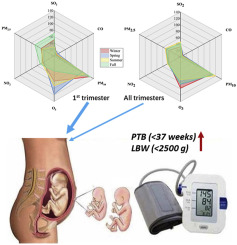当前位置:
X-MOL 学术
›
Ecotox. Environ. Saf.
›
论文详情
Our official English website, www.x-mol.net, welcomes your
feedback! (Note: you will need to create a separate account there.)
Seasonal response of the synergism of maternal comorbidities and long-term air pollution exposure on birth outcomes.
Ecotoxicology and Environmental Safety ( IF 6.2 ) Pub Date : 2020-01-24 , DOI: 10.1016/j.ecoenv.2020.110232 Boyi Zhao 1 , Min Wang 2 , Changwei Lü 3 , Ling Feng 3 , Hua Ma 1 , Haixia Meng 2 , Muge Qi 2 , Qingyun Fan 4 , Haoji Wang 1 , Haijun Zhou 5 , Jiang He 3
Ecotoxicology and Environmental Safety ( IF 6.2 ) Pub Date : 2020-01-24 , DOI: 10.1016/j.ecoenv.2020.110232 Boyi Zhao 1 , Min Wang 2 , Changwei Lü 3 , Ling Feng 3 , Hua Ma 1 , Haixia Meng 2 , Muge Qi 2 , Qingyun Fan 4 , Haoji Wang 1 , Haijun Zhou 5 , Jiang He 3
Affiliation

|
Air pollution has been considered as one of the most important factors associating with various birth outcomes. However, the seasonal response of maternal comorbidities effects associated with air pollution has not been investigated, especially in the city with distinguish seasonal pattern and long heating seasons. In this work, 69,945 live births were investigated from 2013 to 2016, and the seasonal relationship between air pollution and preterm birth and low birth weight were assessed, as well as the synergism of maternal comorbidities. Exposures of six pollutants were assigned to maternal residences during pregnancy. The potential effect modification by maternal comorbidities on the associations was evaluated between prenatal air pollution and preterm birth (PTB), as well as effects of seasons and trimesters. Adjusting for seasonality, all six pollutants presented seasonal relationship with preterm birth, which CO, PM10, NO2, and PM2.5 were with [odds ratio (OR) = 1.035 95% CI: 1.015, 1.055, OR = 1.039 95% CI: 1.034, 1.045, OR = 1.042, 95% CI: 1.029, 1.056 and OR = 1.085 95% CI 1.073, 1.097, respectively] for tenth quartile of 10 μg/m3 range increased in autumn (the beginning of heating season). For O3, it associated with PTB in winter and spring with OR = 1.113 95% CI: 1.104, 1.123, and OR = 1.155 95% CI: 1.145, 1.165, respectively. The OR increase of PTB for exposure to all six pollutants was higher among women with preeclampsia and gestational hypertension. The associations between ambient air pollution and preterm birth were modified by gestational hypertension and preeclampsia. The seasonal patterns of six studied air pollutants increases the risk of PTB in autumn and winter distinguishably, which may due to the sudden increased concentrations of pollutants emitted by traditional heating. The seasonal response of the synergism of maternal comorbidities and long-term air pollution exposure on birth outcomes is supported by the data sets of preterm birth.
中文翻译:

产妇合并症与长期空气污染暴露对分娩结局协同作用的季节性响应。
空气污染被认为是与各种出生结果相关的最重要因素之一。但是,尚未研究与空气污染相关的母婴合并症影响的季节性响应,特别是在城市具有明显的季节性模式和较长的供暖季节的城市。在这项工作中,2013年至2016年对69,945例活产婴儿进行了调查,评估了空气污染与早产与低出生体重之间的季节性关系,以及母亲合并症的协同作用。在怀孕期间,将六种污染物的暴露分配给了母亲住所。通过产前合并症对产前空气污染和早产(PTB)以及季节和孕中期的影响,评估了母体合并症对这种关联的潜在影响。调整季节性因素后,所有六种污染物均与早产呈季节关系,其中CO,PM10,NO2和PM2.5的[比值比(OR)= 1.035 95%CI:1.015,1.055,OR = 1.039 95%CI:1.034,1.045,秋季(供暖季节开始),第十个四分位数的10μg/ m3范围的样品,OR = 1.042、95%CI:1.029、1.056和OR = 1.085 95%CI 1.073、1.097。对于O3,它与冬季和春季的PTB相关,OR分别为OR = 1.113 95%CI:1.104、1.123和OR = 1.155 95%CI:1.145,1.165。子痫前期和妊娠高血压妇女中暴露于所有六种污染物的PTB的OR升高较高。妊娠高血压和先兆子痫改变了周围空气污染与早产之间的联系。研究的六种空气污染物的季节变化明显增加了秋季和冬季发生PTB的风险,这可能是由于传统采暖排放的污染物浓度突然增加所致。产妇合并症和长期空气污染暴露对出生结局协同作用的季节性响应得到早产数据集的支持。
更新日期:2020-01-26
中文翻译:

产妇合并症与长期空气污染暴露对分娩结局协同作用的季节性响应。
空气污染被认为是与各种出生结果相关的最重要因素之一。但是,尚未研究与空气污染相关的母婴合并症影响的季节性响应,特别是在城市具有明显的季节性模式和较长的供暖季节的城市。在这项工作中,2013年至2016年对69,945例活产婴儿进行了调查,评估了空气污染与早产与低出生体重之间的季节性关系,以及母亲合并症的协同作用。在怀孕期间,将六种污染物的暴露分配给了母亲住所。通过产前合并症对产前空气污染和早产(PTB)以及季节和孕中期的影响,评估了母体合并症对这种关联的潜在影响。调整季节性因素后,所有六种污染物均与早产呈季节关系,其中CO,PM10,NO2和PM2.5的[比值比(OR)= 1.035 95%CI:1.015,1.055,OR = 1.039 95%CI:1.034,1.045,秋季(供暖季节开始),第十个四分位数的10μg/ m3范围的样品,OR = 1.042、95%CI:1.029、1.056和OR = 1.085 95%CI 1.073、1.097。对于O3,它与冬季和春季的PTB相关,OR分别为OR = 1.113 95%CI:1.104、1.123和OR = 1.155 95%CI:1.145,1.165。子痫前期和妊娠高血压妇女中暴露于所有六种污染物的PTB的OR升高较高。妊娠高血压和先兆子痫改变了周围空气污染与早产之间的联系。研究的六种空气污染物的季节变化明显增加了秋季和冬季发生PTB的风险,这可能是由于传统采暖排放的污染物浓度突然增加所致。产妇合并症和长期空气污染暴露对出生结局协同作用的季节性响应得到早产数据集的支持。









































 京公网安备 11010802027423号
京公网安备 11010802027423号